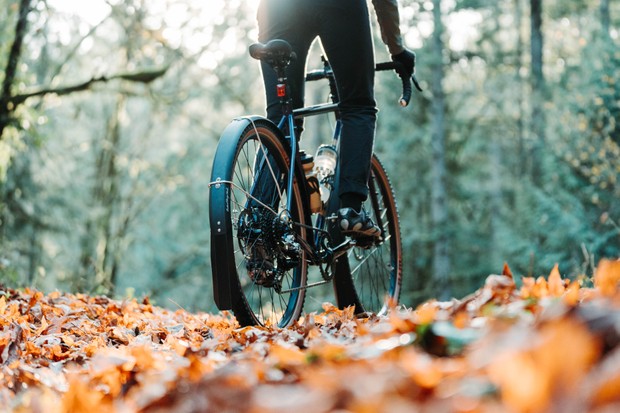Science
Everything you need to know about gravel bike mudguards: how to stay clean and dry through winter

|
|
Keeping mud and grit under your tyres makes winter gravel riding heaps better
For the yet-to-be-converted, mudguards – or fenders – can be a real game-changer for winter gravel riding, or any wet-weather conditions for that matter.
But aren’t dirt, gravel and grit all part of off-road riding? And what are the mudguard/fender options out there for gravel bikes?
Here, we look into why you should consider fitting mudguards to your gravel bike, as well as the different options for all types of bike (and budget) and the practical considerations you need to take into account before plunging into foul-weather bliss.
Why should you fit mudguards to a gravel bike?

The pros…
We’ve touched on the plus-sides already: just like road bike mudguards, gravel ‘guards essentially limit the amount of water, mud and debris that flicks up off your gravel tyres and onto you or your bike.
How effective that protection is will depend on how much coverage your mudguards offer.

Options range from minimal strap-on mudguards that offer light relief for your face or backside, to full-length mudguards that give much more protection, helping to keep you dry from head-to-toe, while also maintaining your bike frame and components in better condition.
Keeping water and muck off your body will help you feel comfortable on the bike. If it’s cold and you’re wet, you’re more likely to catch a chill, and no one enjoys sitting on a soggy chamois.

Riding off-road is also inherently tougher on bike components, including your drivetrain, where grit, stones and sand can quickly combine to become a component-eating paste. So besides keeping you warm and dry, fitting mudguards can help prolong the lifespan of your bike parts. This surely makes them one of the best gravel bike accessories going.
The cons…
Well, as with anything, there can be downsides to fitting mudguards on your gravel bike.
Firstly, there’s the matter of clearance. Adding an extra layer of metal or plastic around your tyres needs space, especially where potential trail debris is factored into the equation, and not all off-road bikes have the clearance to add mudguards, particularly if you still want to run a chunky tyre.

You may find that you need to run a smaller-volume tyre in order to run mudguards on your gravel bike, or even opt for a smaller wheel size by switching from 700c wheels for 650b to give extra space, if your bike offers compatibility.
Adding mudguards to your bike will also add weight, though exactly how much depends on what type you opt for. Unless you’re racking up serious climbing, the extra protection on offer will likely offset any weight gain.
Finally, fitting mudguards can sometimes be a bit trickier than you’d expect. It’s worth taking your time to get the fit just right, or asking a local mechanic to help out.
Front mudguard, rear mudguard or both?

While road riders will typically mount a set of mudguards at both the front and rear of the bike, gravel riders or mountain bikers may opt to run a ‘guard at only one end.
Why? Well, the front and rear mudguards serve slightly different purposes, and how much you value front or rear protection will depend on your personal preferences.
While the front mudguard acts mostly to stop mud flicking up off your front tyre into your face, the rear mudguard functions mostly to stop spray hitting your rear end.
Full-length mudguards with flaps also help to keep this filth off your feet and bike, which can be largely attributed to the front mudguard.
Most riders tend to opt for both front and rear mudguards for greater protection, though there’s no reason why you couldn’t run just one or the other.
Three types of gravel mudguard
Generally speaking, there are three types of gravel mudguard: short-coverage clip-on mudguards (available for either the front or, more commonly, the rear), full-coverage clip-on mudguards and full-coverage mudguards that require eyelets.
Choosing the most suitable option will depend on exactly what you want from your mudguard(s) and what you can fit to your bike.
Short-coverage clip-on mudguards

Let’s start off with the most minimal mudguards on the market.
Short-coverage, clip-on mudguards are pretty much as you’d expect; they offer relatively limited coverage, compared to full-length guards, but can be fitted to any bike, because you can strap, clip or cable-tie them onto your frame without the need for mudguard eyelets.
You might not get the same full-body protection as a longer set of mudguards, but if you value rear-end protection above all else, and you want tool-free fitment, you’ll be covered here.
Generally, the minimalist design means frame and mud clearance is less of an issue, too.

The Mudhugger Gravel Hugger is one such example of a short-coverage clip-on mudguard.
The Gravel Hugger is a gravel-specific set of the brand’s popular mountain bike mudguards, mounting onto the fork and seatstays using cable ties or rubber O-rings.
Latest deals on the Mudhugger Rear Gravel Hugger

As for a rear-only option, we highly rate the Ass Savers Win Wing.
This super-minimalist – and lightweight – mudguard offers rear-tyre protection via a wishbone stay and silicone straps.
Latest deals on the Ass Savers Win Wing
Full-coverage clip-on mudguards

If you’re looking for more extensive coverage, but your bike is not kitted out with mudguard eyelets, consider a set of clip-on mudguards.
These typically attach directly to the frame using silicone straps, but look more like a traditional set of mudguards.

An example is the SKS Speedrocker, designed for gravel riding and cyclocross with a wider mudguard to accommodate both 700c and 650b wheels with tyres up to 42mm wide. These attach to the fork and seatstays in two places using rubberised hook and loop fastenings.
Although less secure than mudguards fitted using frame eyelets, some riders prefer clip-on mudguards because they are easier to take on and off.
Latest deals on the SKS Speedrocker mudguards
Full-coverage fixed mudguards

To maximise protection from dirt and puddles, opt for full-coverage mudguards. You’ll need to make sure you have suitable mudguard eyelets on your frame and fork for these.
Often, these can be a little trickier to fit (they aren’t an option you’ll want to fit and remove on a regular basis), but once secured, give the best protection and are the sturdiest option.
One example is the Kinesis Fend-Off Wide, a gravel-friendly (and, as a result, wider) version of the brand’s standard Fend-Off mudguards.
The anodised aluminium guards are secured using metal stays that run to the frame’s eyelets near the axles, as well as to the top of the fork, and seatstay bridge and rear of the seat tube.
The guards also use polypropylene flaps, which attach to the rear of the front and rear guards, reducing the mud spray that ends up on you (mainly your feet), your bike, and your ride pals.
Latest deals on the Kinesis Fend-Off Wide mudguards
What to look for in gravel bike mudguards
Not all mudguards will work for all bikes, but it doesn’t have to be a nightmare to figure out what will work best for you.
Does your gravel bike have mudguard eyelets?

Check whether your bike has eyelets for mounting fixed mudguards around the axles, fork crown, seatstay bridge and base of the seat tube. If your bike has these, then you have full choice across the different types of mudguards.
If your gravel bike doesn’t have mudguard eyelets, then you’ll need to opt for clip-on mudguards.
How much protection do you need?

Whether you opt for short-coverage mudguards for low weight and ease-of-use, or long-coverage mudguards for maximum protection, is largely down to personal preference, where you’re riding and who you’re riding with.
Short-coverage clip-on mudguards will be adequate for keeping the worst of the muck off of you. However, if you plan on riding regularly with friends or in groups, then longer-coverage guards – especially those with flaps – will be better (read: more courteous) for keeping anyone riding behind you dry. Many club riders will tell you that longer-coverage mudguards are the sociable choice.
The worse the conditions you ride in, the more you’re likely to benefit from long-coverage mudguards.
Having said that, even clip-on long-coverage mudguards aren’t as easy to fit as many short-coverage options. Also, because they tend to fit closer to the tyre than short-coverage guards, you may need to be more cautious of trail debris.
This leads us neatly to our next important consideration…
Frame, tyre and mud clearance

Just like when you’re buying a gravel bike, considering clearance is key.
You’ll need to make sure you have adequate frame clearance to fit your mudguards, as well as ensuring you have enough space between the tyre and mudguard.
Check the maximum tyre clearances recommended by the mudguard brand as well as any clearance and tyre-width recommendations that accompany your bike.
This is especially critical when it comes to riding off-road because your tyres often pick up mud, stones and other trail debris that needs to pass under the mudguards.
If it’s muddy and there’s insufficient clearance, you’re likely to get a build-up of mud at best – or risk damaging your frame at worst.
Similarly, trail debris such as twigs can cause havoc if trapped with insufficient space between the tyre and mudguard.
Bag clearance

While we’re on the topic of clearance, you also need to think about bag clearance if you’re loading up your bike for a bikepacking trip or going touring.
The good news is that seatpost-mounted bikepacking bags essentially act as short-coverage rear mudguards, so might save you fixing one up if you’re planning a longer trip (although, for this reason, make sure your bag is made from a muck-proof material).
If you are running mudguards, check you have a good gap between any bags and your guards to prevent any damage.
Even the weight of a bag on a mudguard can cause it to become mis-shaped, which can get pretty noisy.
Frame protection

If you’re using any type of clip-on mudguard, it’s wise to think about using frame protection where it attaches to your bike.
It might seem like overkill, but it only takes a tiny bit of grit to work its way under the zip tie, rubber strap or Velcro attachment to wreak havoc with your paintjob.
Before fitting your mudguards, adding frame protection patches such as those offered by Pro or Restrap, or alternatively opting for areas of Helitape, will help keep your bike in good condition.
Are there mudguards designed for your bike?

A few of the more mainstream brands offer mudguards designed specifically to fit certain models.
For example, Canyon sells mudguards to complement its Grail gravel bikes, while Scott also offers mudguards made specifically for its bike models.
It’s worth checking to see if there are any mudguards available for your specific gravel bike before browsing alternatives.
The important matter of flaps

Last but not least, have you considered adding flaps to your long-coverage mudguards?
Some are supplied with them, others may require flaps to be bought separately – or you can make your own mud flap.
Essentially, the longer the flap is, and the closer it sits to the ground, the more coverage you, and the person riding behind you, will benefit from.
Plastic, rubber or even leather; there are flaps to suit all budgets and styles.





Science
Giant prehistoric salmon had tusk-like teeth for defence, building nests: study – Vancouver Sun


It’s hard to know exactly why the relatives of today’s sockeye went extinct


Article content
The artwork and publicity materials showcasing a giant salmon that lived five million years ago were ready to go to promote a new exhibit, when the discovery of two fossilized skulls immediately changed what researchers knew about the fish.
Initial fossil discoveries of the 2.7-metre-long salmon in Oregon in the 1970s were incomplete and had led researchers to mistakenly suggest the fish had fang-like teeth.
Advertisement 2
Article content
Article content
It was dubbed the “sabre-toothed salmon” and became a kind of mascot for the Museum of Natural and Cultural History at the University of Oregon, says researcher Edward Davis.
But then came discovery of two skulls in 2014.
Davis, a member of the team that found the skulls, says it wasn’t until they got back to the lab that he realized the significance of the discovery that has led to the renaming of the fish in a new, peer-reviewed study.
“There were these two skulls staring at me with sideways teeth,” says Davis, an associate professor in the department of earth sciences at the university.
In that position, the tusk-like teeth could not have been used for biting, he says.
“That was definitely a surprising moment,” says Davis, who serves as director of the Condon Fossil Collection at the university’s Museum of Natural and Cultural History.
“I realized that all of the artwork and all of the publicity materials and bumper stickers and buttons and T-shirts we had just made two months prior, for the new exhibit, were all out of date,” he says with a laugh.
Davis is co-author of the new study in the journal PLOS One, which renames the giant fish the “spike-toothed salmon.”
Article content
Advertisement 3
Article content
It says the salmon used the tusk-like spikes for building nests to spawn, and as defence mechanisms against predators and other salmon.
The salmon lived about five million years ago at a time when Earth was transitioning from warmer to relatively cooler conditions, Davis says.
It’s hard to know exactly why the relatives of today’s sockeye went extinct, but Davis says the cooler conditions would have affected the productivity of the Pacific Ocean and the amount of rain feeding rivers that served as their spawning areas.
Another co-author, Brian Sidlauskas, says a fish the size of the spike-toothed salmon must have been targeted by predators such as killer whales or sharks.
“I like to think … it’s almost like a sledgehammer, these salmon swinging their head back and forth in order to fend off things that might want to feast on them,” he says.
Sidlauskas says analysis by the lead author of the paper, Kerin Claeson, found both male and female salmon had the “multi-functional” spike-tooth feature.
“That’s part of our reason for hypothesizing that this tooth is multi-functional … It could easily be for digging out nests,” he says.
Advertisement 4
Article content
“Think about how big the (nest) would have to be for an animal of this size, and then carving it out in what’s probably pretty shallow water; and so having an extra digging tool attached to your head could be really useful.”
Sidlauskas says the giant salmon help researchers understand the boundaries of what’s possible with the evolution of salmon, but they also capture the human imagination and a sense of wonder about what’s possible on Earth.
“I think it helps us value a little more what we do still have, or I hope that it does. That animal is no longer with us, but it is a product of the same biosphere that sustains us.”
Bookmark our website and support our journalism: Don’t miss the news you need to know — add VancouverSun.com and TheProvince.com to your bookmarks and sign up for our newsletters here.
You can also support our journalism by becoming a digital subscriber: For just $14 a month, you can get unlimited access to The Vancouver Sun, The Province, National Post and 13 other Canadian news sites. Support us by subscribing today: The Vancouver Sun | The Province.
Article content
Science
Hundreds of black ‘spiders’ spotted in mysterious ‘Inca City’ on Mars in new satellite photos


|
|
Arachnophobes need not fear: A new European Space Agency (ESA) image of Martian “spiders” actually shows seasonal eruptions of carbon dioxide gas on the Red Planet.
The dark, spindly formations were spotted in a formation known as Inca City in Mars‘ southern polar region. Images taken by ESA’s Mars Express orbiter and ExoMars Trace Gas Orbiter show dark clusters of dots that appear to have teeny little legs, not unlike baby spiderlings huddling together.
The formations are actually channels of gas measuring 0.03 to 0.6 miles (45 meters to 1 kilometer) across. They originate when the weather starts to warm in the southern hemisphere during Martian spring, melting layers of carbon dioxide ice. The warmth causes the lowest layers of ice to turn to gas, or sublimate.
As the gas expands and rises, it explodes out of the overlying ice layers, carrying with it dark dust from the solid surface. This dust geysers out of the ice before showering down onto the top layer, creating the cracked, spidery pattern seen here. In some places, the geysers burst through ice up to 3.3 feet (1 m) thick, according to ESA.
Related: Single enormous object left 2 billion craters on Mars, scientists discover


Inca City is also known as Angustus Labyrinthus. It’s named for its linear, ruin-like ridgelines, which were once thought to be petrified sand dunes or perhaps remnants of ancient Martian glaciers, which could have left high walls of sediment behind as they retreated.
In 2002, however, the Mars Orbiter revealed that Inca City is part of a circular feature approximately 53 miles (86 km) wide. This feature may be an old impact crater — suggesting that the geometric ridges may be magma intrusions that rose through the cracked, heated crust of Mars after it was hit by a renegade space rock. The crater would have then filled with sediment, which has since eroded, partially revealing the magma formations reminiscent of ancient ruins.





Science
Hubble Space Telescope marks 34 years with new portrait of a ‘cosmic dumbbell’
-
Real eState24 hours ago
Montreal tenant forced to pay his landlord’s taxes offers advice to other renters
-
Media23 hours ago
B.C. online harms bill on hold after deal with social media firms
-



 Investment24 hours ago
Investment24 hours agoMOF: Govt to establish high-level facilitation platform to oversee potential, approved strategic investments
-



 Politics23 hours ago
Politics23 hours agoPolitics Briefing: Younger demographics not swayed by federal budget benefits targeted at them, poll indicates
-
News23 hours ago
Just bought a used car? There’s a chance it’s stolen, as thieves exploit weakness in vehicle registrations
-



 Science23 hours ago
Science23 hours agoGiant prehistoric salmon had tusk-like spikes used for defence, building nests: study
-



 Tech22 hours ago
Tech22 hours agoCalgary woman who neglected elderly father spared jail term
-
Real eState22 hours ago
Luxury Real Estate Prices Hit a Record High in the First Quarter






Comments